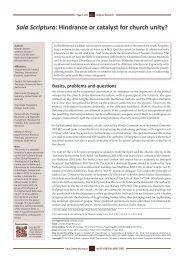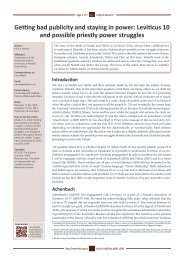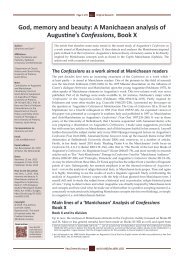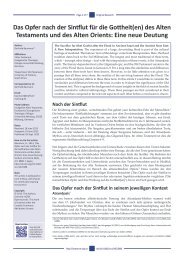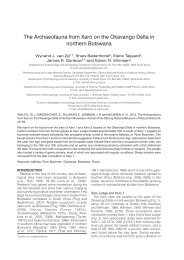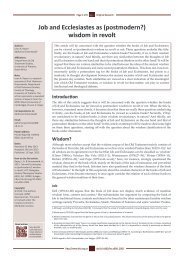Development of a Rift Valley fever real-time RT-PCR assay that can ...
Development of a Rift Valley fever real-time RT-PCR assay that can ...
Development of a Rift Valley fever real-time RT-PCR assay that can ...
You also want an ePaper? Increase the reach of your titles
YUMPU automatically turns print PDFs into web optimized ePapers that Google loves.
430 W.C. Wilson et al. / Journal <strong>of</strong> Virological Methods 193 (2013) 426–431<br />
control, the <strong>assay</strong> with the XIPC control did consistently detect the<br />
S-segment target. Overall, the quadruplex <strong>assay</strong> performed better<br />
with inclusion <strong>of</strong> the XIPC control when compared to using the<br />
armored enterovirus RNA control or the triplex format.<br />
4. Discussion<br />
The possible unintentional or intentional introduction <strong>of</strong> RVFV<br />
into a non-endemic country is <strong>of</strong> signifi<strong>can</strong>t concern and it is therefore<br />
considered a high priority zoonotic disease (Chevalier et al.,<br />
2010; Hartley et al., 2011). Disease outbreaks begin in domestic<br />
livestock but <strong>of</strong>ten go undetected until human cases are confirmed.<br />
Therefore, there is a need for diagnostic tools <strong>that</strong> rapidly and<br />
specifically detect RVF virus in samples from infected animals. A<br />
number <strong>of</strong> <strong>assay</strong>s are available for RVF diagnosis but many are not<br />
readily available in non-endemic countries (Wilson et al., 2013).<br />
Ideally, for non-endemic countries these <strong>assay</strong>s should be safe to<br />
produce, store and handle in veterinary diagnostic laboratories.<br />
Genetic amplification <strong>assay</strong>s, including <strong>real</strong>-<strong>time</strong> <strong>RT</strong>-<strong>PCR</strong> <strong>assay</strong>s,<br />
meet these desired requirements. A sample handling protocol <strong>that</strong><br />
quickly inactivates the potentially infected sample, yet facilitates<br />
nucleic acid extraction, leading to a single tube r<strong>RT</strong>-<strong>PCR</strong> <strong>assay</strong><br />
<strong>that</strong> includes an internal exogenous RNA amplification control was<br />
developed previously (Drolet et al., 2012). The current r<strong>RT</strong>-<strong>PCR</strong><br />
<strong>assay</strong>s all detect a single region on the RVF viral genome. Although<br />
the RVFV genome is highly conserved (Bird et al., 2007b; Grobbelaar<br />
et al., 2011), genetic mutation <strong>that</strong> could affect the sensitivity<br />
<strong>of</strong> the <strong>assay</strong> always remains a possibility. The detection <strong>of</strong> RVF<br />
in a non-endemic country could have signifi<strong>can</strong>t socio-economic<br />
implications. The <strong>assay</strong> design reported here is advantageous over<br />
previous <strong>assay</strong>s in <strong>that</strong> it detects all three RVF viral genome segments,<br />
each with a different reporter dye. This design thus provides<br />
internal confirmation within a single tube <strong>assay</strong>. It is also useful<br />
in endemic countries <strong>that</strong> are using the licensed Clone 13 vaccine<br />
(von Teichman et al., 2011) in <strong>that</strong> the S segment target is<br />
within the deleted portion <strong>of</strong> this product. The ability to differentiate<br />
infected from vaccinated RVF viral RNA would have a limited<br />
<strong>time</strong> frame <strong>of</strong> effectiveness since the RNA persists from 2 to 6 days<br />
post infection or vaccination (Drolet et al., 2012). During the evaluation<br />
in South Africa there was an incident where vaccination had<br />
occurred just prior to observation <strong>of</strong> clinical disease in a sheep<br />
herd. In these samples this quadruplex analysis was found to be<br />
useful because it was able to establish <strong>that</strong> vaccine was present in<br />
some but also wild-type RVFV was present in other samples from<br />
this herd (data incorporated in overall evaluation). Thus wild-type<br />
infection had occurred too soon after vaccination to prevent clinical<br />
disease observed. The sensitivity <strong>of</strong> the <strong>assay</strong> depends signifi<strong>can</strong>tly<br />
on the sample size and extraction protocol. When whole blood or<br />
serum samples were analyzed where the amount <strong>of</strong> material was<br />
not limited, the quadruplex <strong>assay</strong> was <strong>of</strong> identical sensitivity to<br />
standard <strong>assay</strong>s currently in use. The tissue samples evaluated were<br />
from the 2010 South Africa RVF outbreak and were processed by<br />
one staff member who was vaccinated for RVF. To facilitate the sample<br />
handling process, swabs <strong>of</strong> the tissue sample were later used in<br />
many <strong>of</strong> the cases. In this case the amount <strong>of</strong> target RNA was more<br />
limited. The quadruplex <strong>assay</strong> was not as sensitive as the monoplex<br />
<strong>assay</strong> in detecting RNA in these samples (Drosten et al., 2002). All<br />
<strong>of</strong> the samples scored as “not detected”, had high Ct values >30,<br />
except for one with a value <strong>of</strong> >26 with the monoplex <strong>assay</strong>. These<br />
<strong>assay</strong>s were done on frozen samples and 3 <strong>of</strong> the negative samples<br />
were also negative by monoplex as the <strong>time</strong> <strong>of</strong> the evaluation.<br />
It is not surprising <strong>that</strong> a quadruplex <strong>assay</strong> would have reduced<br />
sensitivity, but this <strong>can</strong> likely be improved by a small increase in<br />
the amount <strong>of</strong> extracted material used and/or improved extraction<br />
processes.<br />
Two external RNA amplification controls were evaluated as useful<br />
additions to allow for the detection <strong>of</strong> <strong>PCR</strong> inhibitors. Both the<br />
armored enterovirus RNA (Drolet et al., 2012) and the XIPC controls<br />
(Schroeder et al., 2012) worked well with a majority <strong>of</strong> the<br />
samples and strains tested, however, the armored enterovirus RNA<br />
deleteriously affected the detection <strong>of</strong> the S segment target for a<br />
few strains. This may be due to run-to-run variations <strong>of</strong> the levels<br />
<strong>of</strong> S target. At the <strong>time</strong> <strong>of</strong> this analysis, the RNA from these<br />
samples was limited and further evaluation <strong>of</strong> these two external<br />
positive controls could not be re-run. The inconsistency with the<br />
armored enterovirus RNA was only noted in 30% <strong>of</strong> samples where<br />
the S target was detected in the triplex format (unpublished data).<br />
The design was limited to the NSs-encoding region <strong>of</strong> the RVF S<br />
viral genome segment, for DIVA compatibility with NSs-deleted<br />
attenuated vaccines. Four NSs primer sets were evaluated before<br />
a suitable pair was found to be effective and not to interfere with<br />
the L and M primers and probes. In future studies, the primer and<br />
probe sets targeting the L and M segments could be redesigned to<br />
reduce observed primer interaction, thus allow for a more consistent<br />
detection <strong>of</strong> the NSs target region. However, with the XIPC<br />
control the <strong>assay</strong> appeared to have improved specificity, detecting<br />
all three targets for all the strains evaluated. The L and M primer<br />
designs are from previously published procedures and are effectively<br />
being used in veterinary diagnostic laboratories currently.<br />
Therefore, to redesign the primer/probes at this <strong>time</strong> due to inconsistency<br />
with the enterovirus RNA control is not appropriate. The<br />
human clinical samples were run prior to the addition <strong>of</strong> the XIPC<br />
control. Unfortunately, these samples were no longer available to<br />
re-run using the current design. To obtain an overall estimate <strong>of</strong> the<br />
sensitivity using the available data, the veterinary and human data<br />
sets were combined resulting in an overall sensitivity <strong>of</strong> 82.7% and<br />
specificity <strong>of</strong> 94.6%. The overall evaluation <strong>of</strong> the <strong>assay</strong> was likely<br />
affected by the use <strong>of</strong> multiple RNA purification methods including<br />
both manual and automated procedures.<br />
The triplex primer and probe design for all three genome segments<br />
<strong>of</strong> RVF virus <strong>can</strong> be utilized with a variety <strong>of</strong> instrument<br />
formats. The reporter and quenchers should be chosen according to<br />
the specifications <strong>of</strong> the instrumentants available. In cases where<br />
instruments do not have four-color channel capability, the L and<br />
M probes <strong>can</strong> utilize the same reporter dye using the S target as<br />
the confirmatory reporter for wild-type RNA. The quadruplex <strong>assay</strong><br />
provides a more robust format with internal confirmation, potential<br />
DIVA-compatible RNA marker capability and the capacity to<br />
control for potential <strong>PCR</strong> inhibitors. An external RNA control <strong>can</strong> be<br />
used but in the evaluations the XIPC control had better specificity<br />
with the RVFV strains tested. Thus, the quadruplex <strong>assay</strong> is a useful<br />
new RVF viral genome detection tool for use in both endemic and<br />
non-endemic countries.<br />
Acknowledgements<br />
The authors thank Drs. Mangkey Bounpheng, Alfonso Clavijo,<br />
and Tammy Beckham for providing the XIPC design and Dr. Bounpheng<br />
for an early review <strong>of</strong> this manuscript. The authors also<br />
thank Drs. Juergen Richt and D. Scott McVey for early review <strong>of</strong><br />
this manuscript. This project was supported in part by the US<br />
Department <strong>of</strong> Agriculture, Agricultural Research Service Project<br />
#58-5430-005-00D through inter-agency agreements with the<br />
Science and Technology Directorate <strong>of</strong> the U.S. Department <strong>of</strong><br />
Homeland Security under Award Number HSHQDC-07-00982 and<br />
the U.S. Department <strong>of</strong> State Biosecurity Engagement Program.<br />
References<br />
Al-Hazmi, M., Ayoola, E.A., Abdurahman, M., Banzal, S., Ashraf, J., El-Bushra, A.,<br />
Hazmi, A., Abdullah, M., Abbo, H., Elamin, A., Al-Sammani el, T., Gadour, M.,



